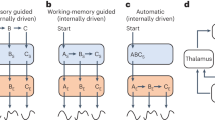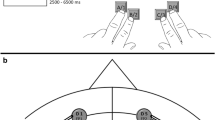Abstract
This study tested the impact of prefrontal-cortex lesion on learning hierarchically structured action sequences. Using a visual-manual serial reaction time task, we had subjects first perform five blocks of trials with a hierarchically structured 14-element action sequence and then tested for sequence-specific learning by introducing a pseudo-random transfer sequence. Relative to control subjects (N = 39), we found that both lateral frontal (N = 16) and medial frontal (N = 18) patients showed reduced overall performance benefits across the training phase. In contrast, the negative transfer test showed significantly increased reaction times in all patient groups, indicating robust sequence-specific learning. This learning was not significantly different from that of the control group. Taken together, the data suggest that learning hierarchically structured action sequences is unimpaired in patients with prefrontal-cortex lesion.



Similar content being viewed by others
References
Bischoff-Grethe A, Goedert KM, Willingham DT, Grafton ST (2004) Neural substrates of response-based sequence learning using fMRI. J Cogn Neurosci 16(1):127–138
Burgess PW (2000) Strategy application disorder: the role of the frontal lobes in human multitasking. Psychol Res 63(3–4):279–288
Burgess PW, Veitch E, de Lacy Costello A, Shallice T (2000) The cognitive and neuroanatomical correlates of multitasking. Neuropsychologia 38(6):848–863
Curran T, Smith MD, DiFranco JM, Daggy AT (2001) Structural influences on implicit and explicit sequence learning. In: Medin DL (ed) The psychology of learning and motivation, vol. 40. Academic, San Diego, pp 147–182
Dienes Z, Berry D (1997) Implicit learning: below the subjective threshold. Psychon Bull Rev 4(1):3–23
Doyon J, Owen AM, Petrides M, Sziklas V, Evans AC (1996) Functional anatomy of visuomotor skill learning in human subjects examined with positron emission tomography. Eur J Neurosci 8(4):637–648
Doyon J, Gaudreau D, Laforce R Jr, Castonguay M, Bedard PJ, Bedard F, et al (1997) Role of the striatum, cerebellum, and frontal lobes in the learning of a visuomotor sequence. Brain Cogn 34(2):218–245
Gomez-Beldarrain M, Grafman J, Pascual-Leone A, Garcia-Monco JC (1999) Procedural learning is impaired in patients with prefrontal lesions. Neurology 52(9):1853–1860
Gomez-Beldarrain M, Grafman J, Ruiz de Velasco I, Pascual-Leone A, Garcia-Monco C (2002) Prefrontal lesions impair the implicit and explicit learning of sequences on visuomotor tasks. Exp Brain Res 142(4):529–538
Hazeltine E, Grafton ST, Ivry R (1997) Attention and stimulus characteristics determine the locus of motor-sequence encoding. A pet study. Brain 120(Pt 1):123–140
Hoffmann J, Koch I (1998) Implicit learning of loosely defined structures. In: Stadler MA, Frensch PA (eds) Handbook of implicit learning. Sage Publications Inc., Thousand Oaks, pp 161–199
Honda M, Deiber MP, Ibanez V, Pascual-Leone A, Zhuang P, Hallett M (1998) Dynamic cortical involvement in implicit and explicit motor sequence learning. A pet study. Brain 121(Pt 11):2159–2173
Jenkins IH, Brooks DJ, Nixon PD, Frackowiak RS, Passingham RE (1994) Motor sequence learning: a study with positron emission tomography. J Neurosci 14(6):3775–3790
Keele SW, Ivry R, Mayr U, Hazeltine E, Heuer H (2003) The cognitive and neural architecture of sequence representation. Psychol Rev 110(2):316–339
Kennerley SW, Sakai K, Rushworth MF (2004) Organization of action sequences and the role of the pre-sma. J Neurophysiol 91(2):978–993
Koch I, Hoffmann J (2000a) Patterns, chunks, and hierarchies in serial reaction-time tasks. Psychol Res 63(1):22–35
Koch I, Hoffmann J (2000b) The role of stimulus-based and response-based spatial information in sequence learning. J Exp Psychol Learn Mem Cogn 26(4):863–882
Miller GA (1956) The magical number seven, plus or minus two: some limits on our capacity for processing information. Psychol Rev 63:81–97
Nissen MJ, Bullemer P (1987) Attentional requirements of learning: evidence from performance measures. Cogn Psychol 19(1):1–32
Pascual-Leone A, Wassermann EM, Grafman J, Hallett M (1996) The role of the dorsolateral prefrontal cortex in implicit procedural learning. Exp Brain Res 107(3):479–485
Reed J, Johnson P (1994) Assessing implicit learning with indirect tests: determining what is learned about sequence structure. J Exp Psychol Learn Mem Cogn 20:585–594
Restle F (1970) Theory of serial pattern learning: structural trees. Psychol Rev 77(6):481–495
Robertson EM, Tormos JM, Maeda F, Pascual-Leone A (2001) The role of the dorsolateral prefrontal cortex during sequence learning is specific for spatial information. Cereb Cortex 11(7):628–635
Sakai K, Kitaguchi K, Hikosaka O (2003) Chunking during human visuomotor sequence learning. Exp Brain Res 152(2):229–242
Shallice T, Burgess PW (1991) Deficits in strategy application following frontal lobe damage in man. Brain 114(Pt 2):727–741
Stuss DT, Alexander MP, Hamer L, Palumbo C, Dempster R, Binns M, et al (1998) The effects of focal anterior and posterior brain lesions on verbal fluency. J Int Neuropsychol Soc 4(3):265–278
Talairach J, Tournoux P (1988) Co-planar stereotaxic atlas of the human brain. Thieme, Stuttgart
Author information
Authors and Affiliations
Corresponding author
Rights and permissions
About this article
Cite this article
Koch, I., Reverberi, C. & Rumiati, R.I. Learning hierarchically structured action sequences is unaffected by prefrontal-cortex lesion. Exp Brain Res 175, 667–675 (2006). https://doi.org/10.1007/s00221-006-0584-6
Received:
Accepted:
Published:
Issue Date:
DOI: https://doi.org/10.1007/s00221-006-0584-6




